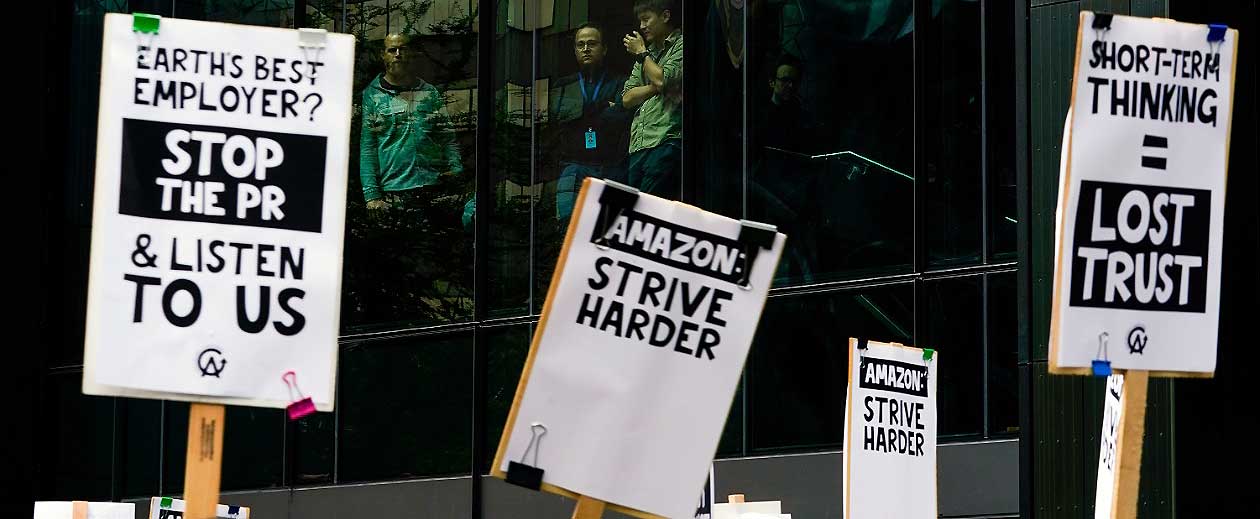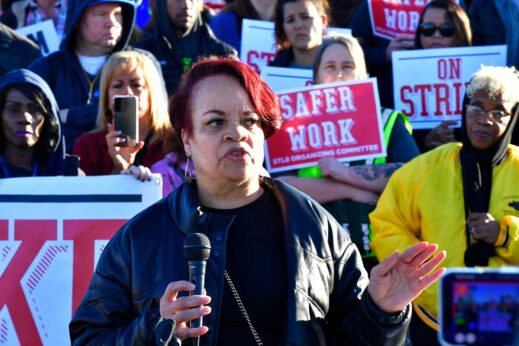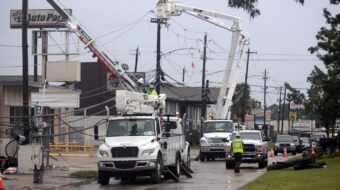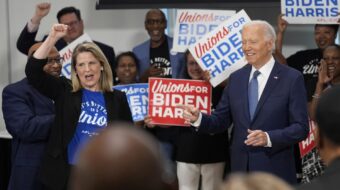
EAST POINT, Ga.—Karen Crawford, an Amazon worker at its ATL6 warehouse in East Point, Ga., is “beyond overworked and grossly underpaid.” She and her daughter sleep on neighbors’ couches. They constantly fear being out on the street with a low-paying job and nowhere to live.
Crawford, an Atlanta native, is not alone at Amazon.
That’s because Amazon is such a dominant market force that it can literally dictate workers’ wages and its payments to its suppliers, a new National Employment Law Project report says. Just like the robber barons of the late 1800s.
Cross Amazon and its owner, Jeff Bezos, you’re out on the street, the National Employment Law Project (NELP) reveals. Cross Amazon as a worker and forget raises from your already low pay.
Cross Amazon as a poster on its website and supplier to its warehouses, and you’re likely to be shuffled to the bottom of its queue, adds a new Federal Trade Commission lawsuit, filed in U.S. District Court in Seattle, adds.

The FTC suit is crammed with details from Amazon’s tax returns and federal corporate filing forms. NELP has them too—and the workers’ tales.
“I make $18.40 an hour and work a minimum of 32 hours a week, which is not nearly enough to pay for basic necessities–like housing, groceries, utilities, my 10-mile commute, and daily expenses, let alone pay tuition for my daughter,” Crawford, who toils at Amazon’s ATL6, told NELP.
“I am currently experiencing homelessness, my daughter and I jumping from couch to couch until we can make enough money to afford a place. Why am I struggling to afford housing when I work for a multi-billion-dollar corporation like Amazon? It doesn’t make any sense,” Crawford says.
“That’s why I decided to organize at my facility about a year ago with the help of United for Respect,” a pro-union organizing drive. “Workers at Amazon deserve a livable wage.”
Magnify its power
The report adds Amazon’s low pay and dangerous working conditions magnify its power to push other firms in a wage race to the bottom.
It paints a bleak picture of the impact of Amazon not just on its workers, but on all workers around their facilities, three-fourths of which are in major metro areas, such as Atlanta, New York, Los Angeles, and Chicago.
In a nutshell, NELP says that when Amazon started invading in 2005, the median wage for warehouse workers in counties with warehouses was 10% below area median wages. Now it’s 30%, the NELP data shows.
The NELP report was one of two big negative hits that Amazon, owned by Jeff Bezos, one of the nation’s three richest people, took on September 27. The other was a Federal Trade Commission lawsuit, filed in U.S. District Court in Seattle, charging Amazon with monopolistic pricing schemes reminiscent of the robber barons of more than a century ago.
“Amazon is a monopolist. It exploits its monopolies in ways that enrich Amazon, but harm its customers: Both the tens of millions of households who regularly shop on Amazon’s online superstore and the hundreds of thousands of businesses who rely on Amazon to reach them,” the FTC said.
“For example, Amazon has hiked so steeply the fees it charges sellers that it now reportedly takes close to half of every dollar from the typical seller that uses Amazon’s fulfillment service. Amazon recognizes sellers find ‘that it has become more difficult over time to be profitable on Amazon due to Amazon’s” market dominance. “As one seller explains, ‘We have nowhere else to go and Amazon knows it.’”
Then Amazon turns around and stiffs its workers, too, says NELP.
“Amazon takes up a bigger part of my life than anything else, yet every day is a struggle to make ends meet for my family,” says one union advocate at the mega-monster’s facility near the St. Louis airport.
Her husband’s disabled from a heart attack, “and the $18 an hour Amazon pays me is not enough to cover our bills, including gas for the car to take him to doctors’ appointments and 20+ miles commutes each way.
“We make impossible choices about whether to pay the electric bill or buy food; Pay the mortgage or buy gas. And it’s not just my family having trouble — sometimes I share food with my coworkers because otherwise they wouldn’t eat.
“My husband and I wait in line for hours at the food pantry every Monday, while Amazon’s chief executives make millions of dollars off of our labor.”
St. Charles County, Mo., Amazon worker Karen Brown spends close to half of her take-home pay on rent, “and an additional $200 per month to take the Amazon van to the distribution center, where her day shift begins at 5:30 a.m. and doesn’t end until after 6 p.m.”
Also works for peanuts
She’s also working for peanuts. The average monthly earnings for all workers in that county are $4,742. By contrast, warehouse workers there only average $2,455 a month. And NELP notes that Amazon’s size and clout nationwide pull down the average pay for all warehouse workers. That’s part of the 30% overall average pay gap between warehouse workers and all workers, the feds say.

In other words, when Amazon moves in, its competitors in that particular metro area cut their pay, too. They have to be “competitive,” after all.
Both the FTC and the union coalition demand Amazon pay more. They also advocate more enforcement actions. NELP would like to see them feature unannounced government visits, 365 days a year. That means OSHA inspections for job safety, and Wage and Hour probes into Amazon’s efforts to repress workers who file for overtime pay. They do so, too, on job safety, NELP says.
“The company’s pay is inadequate compared to other warehouse employers and insufficient for workers to approach even average earnings in the counties where they work. While Amazon tends to operate in higher-earnings counties, warehouse workers in Amazon counties actually take home less each month on average than their counterparts in other U.S. counties,” NELP explains.
“Amazon’s public filings show that by using just one-tenth of its annual profit” of $17.5 billion,
“Amazon could pay each U.S. front-line worker an additional $2,225 a year, or nearly $200 (25%) more per month. In addition, the amount Amazon spent on acquiring other companies in 2022 and 2023 could fund a $16,000 one-time bonus for each U.S. front-line worker,” it calculated.
But instead of using its profits to pay its workers, Amazon bought other companies. One was MGM, for $8,5 billion. It’s one of the major studios whose bosses forced their underpaid 160,000 SAG-AFTRA performers to strike. That strike is still going.
NELP said federal, state, and local governments have the muscle, if they exercise it, to force Amazon into better worker treatment. Heading those “muscle” recommendations is congressional passage of the Protect the Right To Organize (PRO) Act, labor’s #1 legislative priority, which would ease the way for workers to unionize and win first contracts nationwide, not just at Amazon.
Its other recommendations include Amazon raising the wages of its warehouse workers to the median wage, now just over $31,000, for all U.S. workers. The median is the point where half of all workers are above it and half below. NELP also urges Amazon to reverse course and back the PRO Act, and to adopt paid sick and family leave for its workers, given their injuries on the job. It recommends 72 hours of paid sick leave per worker yearly and a minimum of 12 weeks of paid family leave.
NELP’s recommendations for government actions to help the downtrodden Amazon workers include—besides the PRO Act and paid sick and family leave—fair scheduling laws, open data on pay by race, gender, and occupation, and raising the minimum wage and indexing it to inflation.
And to curb the Amazon fueled race to the bottom on pay, lawmakers should ban state governments, almost all of them in red states, from pre-empting local pro-worker laws and establishing ergonomics standards for warehouse workers.
There’s one more move the feds should take to make Amazon accountable.
NELP’s final recommendation is an echo of the Federal Trade Commission’s lawsuit: “Separate Amazon’s major business lines into stand-alone firms to reduce Amazon’s outsize power within the U.S. economy.”












Comments